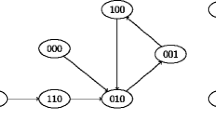Abstract
A variant of matrix representation for Boolean functions is designed such that these functions can be classified by matrix invariants. By way of example, the Deutsch problem is solved to illustrate the advantages of this classification.
Similar content being viewed by others
References
Cooke, D.J. and Bez, H.E., Computer Mathematics, New York: Cambridge Univ. Press, 1984. Translated under the title Komp’yuternaya matematika, Moscow: Nauka, 1990.
Zakrevskii, A.D. and Toropov, N.R., Polinomial’naya realizatsiya chastichnykh bulevykh funktsii i sistem (Polynomial Realization of Partial Boolean Functions and Systems), Moscow: Editorial URSS, 2003.
Peterson, J.L., Petri Net Theory and Modeling of Systems, New York: Prentice-Hall, 1981. Translated under the title Teoriya setei Petri i modelirovanie sistem, Moscow: Mir, 1984.
Calingaert, P., Switch Function Canonical Forms Based on Commutative and Associative Binary Operations, Commun. Electron., 1961, vol. 80, no. 52, pp. 118–121.
Fin’ko, O.A., Realization of Large-Dimensional Systems of Boolean Functions by Modular Arithmetical Methods, Avtom. Telemekh., 2004, no. 6, pp. 37–60.
Shmerko, V.P., Malyugin’s Theorems: A New Interpretation in Logic Control, VLSI, and Structural Data for New Technologies, Avtom. Telemekh., 2004, no. 6, pp. 61–83.
Zakrevskii, A.D., Algorithms for Designing Polynomials Realizing Weakly-Defined Boolean Functions and Systems, Avtom. Telemekh., 2004, no. 6, pp. 158–176.
Malyugin, V.D., Parallel’nye logicheskie vychisleniya posredstvom arifmeticheskikh polinomov (Parallel Logical Computation through Arithmetical Polynomials), Moscow: Nauka, 1997.
Valiev, K.A. and Kokin, A.A., Kvantovye komp’yutery: nadezhdy i real’nost’ (Quantum Computers: Hope and Reality), Moscow: Regulyarnaya i Khaoticheskaya Dinamika, 2002.
Bouwmeester, D., Ekert, A.K., and Zeilinger, A., The Physics of Quantum Information, Berlin: Springer, 2000. Translated under the title Fizika kvantovoi informatsii, Moscow: Postmarket, 2002.
Deutsch, D., Quantum Theory, the Church—Turing Principle and the Universal Quantum Computer, Proc. Roy. Soc. London, 1985, vol. A400, no. 1818, pp. 97–117.
Deutsch, D. and Jozsa, R., Rapid Solution of Problems by Quantum Computation, Proc. Roy. Soc. London, 1992, vol. A439, no. 1907, pp. 553–558.
Dmitriev, A.S. and Panas, A.I., Dinamicheskii khaos: novye nositeli informatsii dlya sistem svyazi (Dynamic Chaos: New Information Carriers for Communication Systems), Moscow: Fizmatlit, 2002.
Golovina, L.I., Lineinaya algebra i nekotorye ee prilozheniya (Linear Algebra and Its Application), Moscow: Nauka, 1985.
Dubrovin, B.A., Novikov, S.P., and Fomenko, A.T., Sovremennaya geometriya: metody i prilozhemiya (Modern Geometry: Methods and Applications), Moscow: Nauka, 1986.
Sing, D.L., Klassicheskaya dinamika (Classical Dynamics), Moscow: Fizmatlit, 1963.
Gibson, W.M. and Pollard, B.R., Symmetry Principles in Elementary Particle Physics, New York: Cambridge Univ. Press, 1976. Translated under the title Printsipy simmetrii v fizike elementarnykh chastits, Moscow: Atomizdat, 1979.
Berezin, A.V., Kurochkin, Yu.A., and Tolmachev, E.A., Kvaterniony v relyativistskoi fizike (Quarternions in Relativistic Physics), Minsk: Nauka i Tekhnika, 1989.
Bogolyubov, N.N. and Shirkov, D.V., Kvantovye polya (Quantum Fields), Moscow: Nauka, 1993.
Lyakhovskii, V.D. and Bolokhov, A.A., Gruppy simmetrii i elementarnye chastitsy (Symmetry Groups and Elementary Particles), Moscow: Editorial URSS, 2002.
Aminov, L.K., Teoriya simmetrii (Theory of Symmetry), Moscow: Inst. Komp. Issl., 2002.
Stratonovich, R.L., Teoriya informatsii (Information Theory), Moscow: Sovetskoe Radio, 1975.
Temnikov, F.E., Afonin, V.A., and Dmitriev, V.I., Teoreticheskie osnovy informatsionnoi tekhniki (Theoretical Principles of Information Technology), Moscow: Energiya, 1979.
Kolpakov, A.A. and Latypov, R.Kh., Approximate Algorithms for Minimization of Binary Decision Diagrams Based on Linear Transformations of Variables, Avtom. Telemekh., 2004, no. 6, pp. 112–128.
Kuz’min, V.B. and Travkin, S.I., Theory of Fuzzy Sets in Control and Principles of Fuzzy Processors, Avtom. Telemekh., 1992, no. 11, pp. 3–36.
Author information
Authors and Affiliations
Additional information
Original Russian Text © A.B. Lapshin, 2006, published in Avtomatika i Telemekhanika, 2006, No. 7, pp. 95–103.
This paper was recommended for publication by O.P. Kuznetsov, a member of the Editorial Board
Rights and permissions
About this article
Cite this article
Lapshin, A.B. Classification of Boolean functions by the invariants of their matrix representation. Autom Remote Control 67, 1100–1107 (2006). https://doi.org/10.1134/S0005117906070095
Received:
Issue Date:
DOI: https://doi.org/10.1134/S0005117906070095



